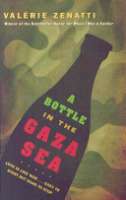
Bottle in the Gaza Sea
Written by Valérie Zenatti
Bloomsbury, 2005, 160 pp.
ISBN: 978-1599902005
I’d like to turn the silence right up, but how do you do that? (p.2)
Imagine you are watching television when you hear an explosion in your neighborhood. Your program is interrupted for an emergency broadcast. Your brother is a soldier working in the occupied territories. Your mother begins crying in the kitchen. Your father isn’t home from work yet. “Will he make it home? Is he okay?” you might wonder. Simultaneously, a young man less than fifty miles away wonders if his father will make it home from his job as a hospital nurse. Will the gates that surround his community be closed? Will there be a curfew? In her novel for young readers, Valérie Zenatti gives voice to dual perspectives, an Israeli teenager and a twenty-year-old Palestinian who become electronic pen pals.
Set in 2003, after the bombing of the Hillel Café, Tal writes a note and places it in a bottle and asks her brother to toss it into the Gaza Sea. The bottle is discovered by a Palestinian who identifies himself as “Gazaman,” ending his first email to Tal dismissively, saying “Goodbye forever” (p. 39), but Tal persists, sending numerous emails. She talks about how Rabin’s assassination has affected her; she questions the killing of innocents and defends her family’s desire for peace. While working on a documentary about Israel, Tal witnesses the bombing of a bus. As she works through her grief and shock, her email relationship with Gazaman deepens. She begins to see things from his perspective. When she hears the news of Israel’s retaliation, she worries about her friend. Interspersed with diary-style chapters from each youth, long periods pass between short flurries of emails. Tal’s voice engages the reader with her ability to say “banal things in a distraught, melodramatic way” (p. 54).
Zanetti has a direct claim to the voice of Tal. She lived in Israel as a teenager and served as a soldier. Tal’s character is sincere with all the concomitant emotional ups and downs of a well-educated teen from a liberal-minded family who lives in a war zone. There are moments of complete normalcy as she interacts with her best friend Efrat and her boyfriend Ori. The book includes factual references to recent events in Israel/Palestine that lend authenticity to the story.
One might question the authenticity of a Jewish author portraying a Palestinian from Gaza, but Zenatti’s “Gazaman” cannot be easily dismissed. When Gazaman writes Tal, he lashes out in anger at the naïveté of this privileged Jewish girl who sends a note in a bottle. Gazaman wants Tal to know the hardship of life in Gaza, the deprivation, the lack of work, and the crowdedness. Just being spied emailing someone in Jerusalem from an Internet café in the Gaza Strip could brand him as a “collaborator” and symbolizes the fear that Palestinians face every day.
Zenatti juxtaposes Gazaman and Tal’s lives, creating tension while allowing for the development of trust. Zenatti encapsulates the tension during an instant messaging dialogue in which the teens decide that, “peace comes from insanity.” Naïm (Gazaman’s name) and Tal joke about building the “Majnun and Mesuga Institute, a Palestinian Israeli Asylum” (p. 121). Naïm’s feelings evolve from anger to love, from defensiveness to compassion. Some critics have questioned this transformation. Would today’s tech-savvy teens wonder why it took Gazaman so long to use the Internet service in a downstairs office of his apartment building rather than at a dangerously public internet cafe, or why he and Tal didn’t catch on to instant messaging much sooner? (Bush, 2008). We believe the novel invites the young reader to consider that other contemporary youth, using the Internet, attending school, struggling with peer and family relationships actually do live in this part of the world that only seems to get attention when another car bomb explodes.
Paired readings for this book might include Valérie Zennati’s When I Was a Soldier (2002), a memoir of her teen years in Israel pre and post military service. Elsa Marston’s Santa Clause in Baghdad and Other Stories about Teens in the Arab World (2008) has additional perspectives from Palestinian youth such as “The Olive Garden” in which a radicalized youth realizes that jihad can be a personal transformation as he shifts from throwing rocks to peaceful protest in the face of Israeli tanks that would plow down his family’s way of life. Another pairing is Marc Aronson’s Unsettled: The Problem of Loving Israel (2008) about an American Jew and his own love/hate relationship with Israel, loving his homeland yet questioning the occupation of Palestine. Background on the history of the region can be helpful to young readers and can be found on the Internet.
Roberta Diamond, University of Arizona, Tucson AZ
Kelly Strachan, University of Arizona, Tucson AZ
Bush, Elizabeth. The Bulletin of the Center for Children’s Books, May 2008, Vol. 61, No. 9. Retrieved from http://www.clcd.com.
WOW Review, Volume V, Issue 3 by Worlds of Words is licensed under a Creative Commons Attribution-NonCommercial-ShareAlike 4.0 International License. Based on work at https://wowlit.org/on-line-publications/review/v-3/
